New publications
How nutrition and telomere dynamics shape beauty and aging processes in women
Last reviewed: 02.07.2025

All iLive content is medically reviewed or fact checked to ensure as much factual accuracy as possible.
We have strict sourcing guidelines and only link to reputable media sites, academic research institutions and, whenever possible, medically peer reviewed studies. Note that the numbers in parentheses ([1], [2], etc.) are clickable links to these studies.
If you feel that any of our content is inaccurate, out-of-date, or otherwise questionable, please select it and press Ctrl + Enter.

Research shows the power of nutrition and telomere dynamics in keeping women healthy and beautiful as they age, offering new perspectives for personalized longevity strategies.
A recent study published in the journal Nutrients looked at the links between health, beauty and the aging process in women.
Health and beauty: the relationship
Health and beauty are closely related, and one influences the perception of the other. Beauty and health research examines the social, biological, and psychological factors that contribute to appearance and health. Aging has a significant impact on both health and beauty, affecting the mind and body. It is important to consider gender differences when studying aging and its effects.
Hormonal changes at different stages of life, especially during menopause, profoundly influence aging, affecting metabolism, bone density, and the cardiovascular system. In addition, differences in telomeres also play a role in the different aging trajectories of men and women. Understanding these differences is important for the development of personalized interventions and therapies.
Health, beauty and public perception
Beauty is traditionally associated with youth, health, and vitality. Health is seen as a state of social, physical, and mental well-being and often underlines the perception of beauty. In many cultures, a healthy body is perceived as more beautiful. Visible signs of health, such as a proportionate figure, glowing skin, and bright eyes, are often associated with beauty ideals.
Women are often perceived as more beautiful if they display signs of health and fertility, while men are attracted to signs of vitality and strength. Hormones play a big role in this context: testosterone promotes masculine traits (large muscle mass, wide jaw, deep voice), while estrogen enhances feminine traits (high cheekbones, smooth skin, full lips).
Biology of Aging
Aging is the progressive decline of physiological functions with age. In general, women live longer than men. In 2021, the average life expectancy for women was 73.8 years, compared to 68.4 years for men. This gap may be due to both biological differences and social norms and behavior. Despite their longer life expectancy, women often experience poorer health in later life.
Telomere Dynamics: A Marker of Cellular Aging
Telomeres are specialized structures at the ends of chromosomes that help maintain genomic stability. They are made up of repetitive DNA sequences that protect the ends of chromosomes from degradation. Telomere shortening is associated with cellular aging, and cells undergo replicative senescence when telomeres shorten to a critical length. Short telomeres are associated with an increased risk of mortality.
The Role of Nutrition in Health and Beauty
Nutrition plays an important role in maintaining health and beauty. A well-balanced diet rich in essential nutrients can support overall health and appearance. Research shows that certain food components, such as polyphenols, vitamins, and antioxidants, can slow down the shortening of telomeres.
Eating a Mediterranean diet is associated with longer telomeres, while diets high in processed foods and sugars are associated with shorter telomeres and accelerated aging.
The study highlights the importance of taking into account sex differences in telomere dynamics to design targeted interventions to address ageing-related health imbalances.
